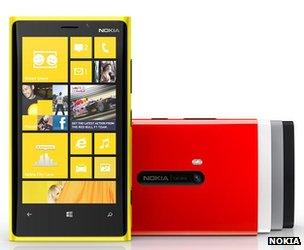Nokia unveils two Windows Phone 8 handsets
- Published
The BBC's Rory Cellan-Jones looks at what sets the Lumia 920 apart from rivals.
Nokia has unveiled its first handsets powered by Microsoft's Windows Phone 8 operating system.
The flagship device - the Lumia 920 - features wireless charging and a "PureView" camera which the mobile firm said offered better video and still images than rival smartphones.
Nokia's loss deepened to 1.41bn euros (£1.1bn) in its last earnings quarter after it lost market share.
Its New York press conference comes in the midst of a number of launches.
Samsung has already shown off a Windows Phone 8 device, and LG and Sony have also recently revealed their new top-of-the-range Android mobiles.
Apple, Motorola and HTC all have events planned over the next three weeks creating extra competition for Nokia as it heads into the busy winter holidays shopping period.
Investors cast doubt over the Finnish firm's chances sending its shares nearly 14% lower.
New features
The Lumia 920 features a Snapdragon S4 processor, a 4.5in (11.4cm) curved screen, and can be used while wearing gloves.
It also features several Nokia-only functions designed to make it stand out from other Windows Phone 8 devices.
The Finnish firm claimed that "floating lens technology" meant the handset could capture up to 10 times the amount of light than other handsets.
It said the advantages were brighter, clearer indoor images that would be less prone to blur caused by unsteady hands than some SLR (single lens reflex) cameras on the market which feature bigger and more expensive lenses.
However, some users may be disappointed it features an 8.7-megapixel sensor, many times below the 41MP resolution sensor on an earlier PureView device.
The firm also updated its mapping technology to feature "City Lens" - an augmented reality app that overlays information about nearby restaurants and other points of interest over live footage of the surrounding area captured by the device's camera.
But the headline feature for many will be the fact that the mobile can be recharged without having to plug it in.
Nokia has fitted the handset with technology allowing it to receive power by magnetic induction from suitable bases. It conforms to the emerging Qi industry standard, which should make the Lumia handset compatible with bases designed for other devices.
In addition to selling its own recharging station, Nokia said the US's Coffee Bean and Tea Leaf chain and Virgin Atlantic's Heathrow airport club lounge would fit equipment allowing visitors to power up the Lumia handsets, offering it fresh opportunities to promote the feature.

The Windows Phone 8 operating system shares much of its code with its desktop equivalent
A cheaper Lumia 820 was also detailed.
It shares the same operating system and NFC (near field communication) technology as the 920, but has a smaller screen, lower quality camera and requires the purchase of an optional exterior shell to add wireless charging.
Challenges ahead
Tony Cripps, principal analyst at tech consultancy Ovum, was positive about the device's chances despite muted sales for Nokia's Windows Phone 7 predecessors.
"The company's focus on improving the imaging capabilities of its smartphones is a reasonable strategy in an age when meaningful differentiation between different makes of smartphone can be hard to identify," he said.
"There could be also a real opportunity here for Nokia and Microsoft to exploit any shortage of Samsung's Android-powered smartphones in the market following the US court ruling against the Korean giant in its patent dispute with Apple, although anything too blatant on that front would seem like a low blow."
But Francisco Jeronimo, research manager at IDC, warned that Nokia would not have the Windows Phone 8 market to itself.
"If Samsung is serious about Windows Phone 8, it will significantly increase its marketing budgets to sell higher volumes than Nokia in the coming quarters," he said.
"It is therefore important for Nokia to continue leading the Windows Phone volumes.
"For that it needs a global launch and not one in 'selected markets' only. When Nokia WP8 devices come out, Nokia will have to execute its best operational and sales skills ever."
- Published5 September 2012
- Published5 September 2012